- Author Matthew Elmers [email protected].
- Public 2023-12-16 21:49.
- Last modified 2025-01-24 09:17.
Self-propelled artillery systems hold the leading position on the front lines. The wheeled and tracked versions of the self-propelled guns available on the market are discussed below.
Recent military operations in Iraq and Afghanistan have spurred the development and delivery of various mine-action armored vehicles, and there is also an order for high-precision artillery systems to provide deterrent fire.
Some countries use both towed and self-propelled (SP) artillery systems, while others plan to switch to using only self-propelled systems.
Of course, there are situations in which standard towed artillery systems are used, like mortars and surface-to-surface missile systems. Towed artillery systems provide a number of significant tactical advantages over heavier self-propelled artillery guns for airborne and naval forces. Towed systems with a conventional barrel caliber of 105-155 mm are quickly transported by helicopter and are currently being successfully used in Afghanistan.
However, self-propelled artillery systems continue to dominate the battlefield, thanks to upgrades in the field of projectiles and loading systems, as well as the support of a number of different systems currently being produced and developed around the world.
Track systems
The Chinese firm North Industries Corporation (NORINCO) has marketed several 152- and 122-mm self-propelled artillery systems and is now producing the PLZ 45, which is a 155 mm / 45-caliber system originally designed to meet the needs of the National Liberation Army (PLA). It has also been exported to Kuwait and, more recently, to Saudi Arabia.
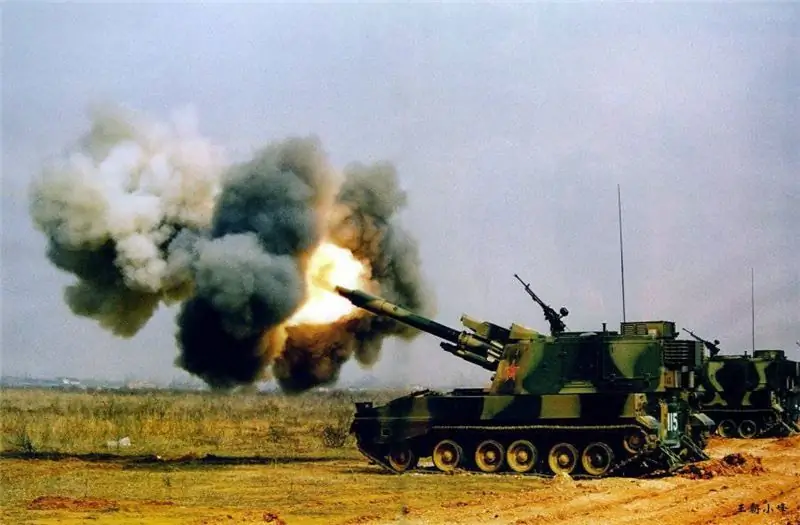
PLZ 45
The maximum range of a standard high-explosive fragmentation projectile with improved aerodynamics and leading belt (HE ER FB) is 30 km, although this distance can be increased to 50 km using the newly developed HE ER FB with a rocket booster and a gas generator (BB RA).
To support the PLZ 45, an auxiliary ammunition vehicle PCZ 45 was developed and produced. It carries up to 90 rounds.
The PLZ 45 and PCZ 45 are marketed by NORINCO as a complete battery and regimental artillery system.
NORINCO has also launched a new fully tracked 122mm SH 3 self-propelled artillery system with a combat weight of 33 tons. The system is equipped with a turret, the cannon of which is loaded with 122mm rounds with a maximum flight range of 15.3 km, provided that it is an HE charge, and a range of 27 km with an HE BB RA charge.
In addition, China is testing a number of new artillery systems, including the PLZ 52 with 152mm / 52 caliber charges and a new 122mm self-propelled amphibious system.
The only barrel artillery system currently in use operated by the German Army is the 155mm / 52 self-propelled caliber PzH 2000 system manufactured by Krauss Maffei Wegmann.
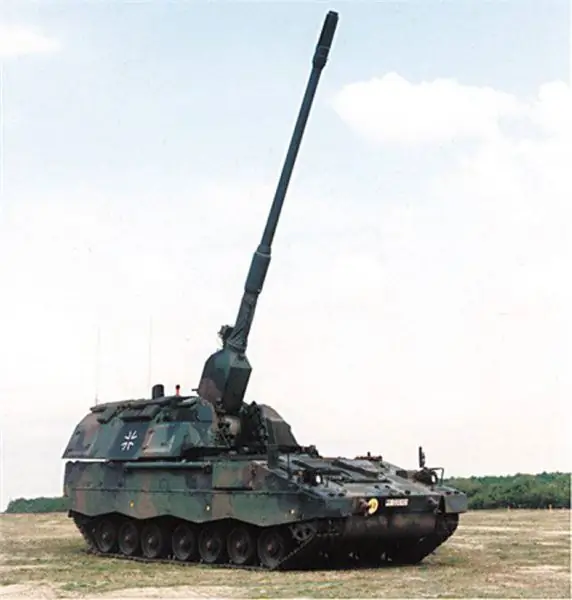
PzH 2000
The German army received a batch of 185 systems, export deliveries were made to Greece (24 systems), Italy (70 systems from the Italian production line) and the Netherlands, which ordered 57 systems; many of them have already been delivered, but some remained as surplus due to the incoming restructuring requests. Production of all ordered PzH 2000s will be completed by the end of this year, but delivery to the market continues.
The combat weight of the PzH 2000 is more than 55 tons, including a semi-automatic projectile charging system and a manually charged modular charge system (MCS). Carries 60 155mm rounds and 288 MCS rounds. The maximum flight range of the 155-millimeter HE L 15 A 2 charge is 30 km, but with the improvement of the projectile, its flight range can be increased to 40 km.
The German army, like a number of other countries, places particular emphasis on rapid reaction forces, and Krauss Maffei Wegmann privately developed the 155mm / 52 caliber Artillery Gun Module (AGM).
The first AGM consisted of the remaining tracked chassis of an M 270 multiple launch rocket system (MLRS), in the stern of which there is a remote control tower, loaded with the same 155mm / 52 caliber charges as in the PhZ 2000. In front of the vehicle is a protected cockpit, from which the crew controls the tool.
The result of further joint development by Krauss Maffei Wegmann and the Spanish company General Dynamics Santa Barbara Sistemas (GDSBS) is the DONAR - 155 mm / 52 calibrated self-propelled artillery system, which was first shown publicly in mid-2008 and is currently being tested.
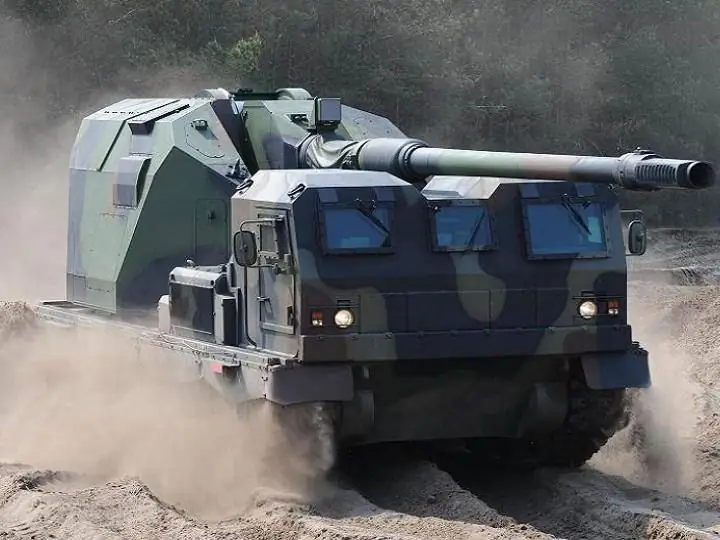
DONAR
DONAR is the latest AGM model, mounted on a new chassis developed by GDSBS based on the latest chassis of the Pizarro 2 airborne assault vehicle currently being produced for the Spanish Army. DONAR weighs 35 tons and is operated by a team of two.
The German army has so far removed all 155mm M 109A3G self-propelled artillery pieces from service, some of which have been sent overseas. Privately, Rheinmetall Weapons and Munitions modularized the M 109 with the M-109 L52, which allows for the full range of 155mm / 52 PhZ 2000 ammunition. It was marketed as a modular system that can be tailored to personal user requirements. …
The standard 155mm self-propelled artillery system of the Italian army today is the modernized M 109 L, equipped with a full complement of 155mm / 39 caliber ammunition carried by the FH-70. Now they are being replaced by 70 PzH 2000, the first 2 of which came from Germany, and the rest are produced under license by Oto Melara. By early July, Oto Melara had produced 51 PzH 2000s, 42 of which were delivered to the Italian Army. Production will be completed in September 2010.
Oto Melara developed for export the Palmaria 155mm / 41 caliber self-propelled artillery system, which was sold to Libya and recently also Nigeria.
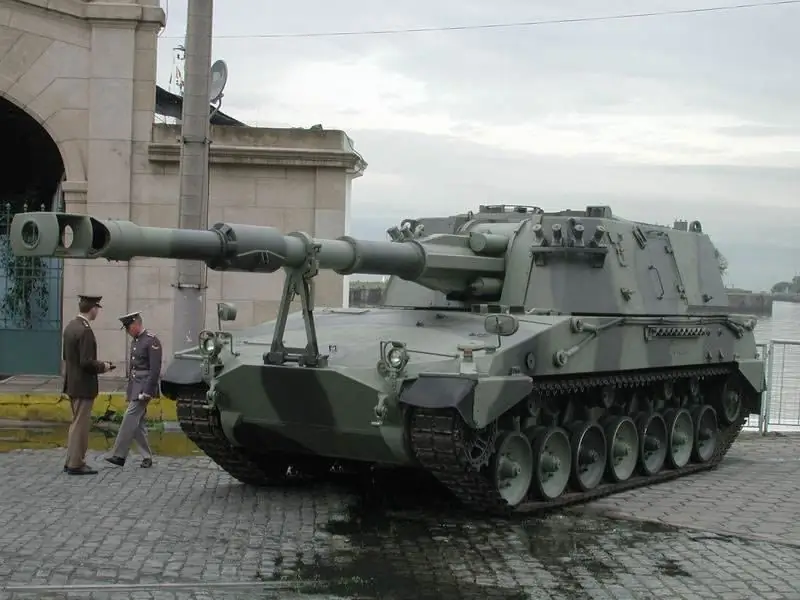
Palmaria 155mm
The turret is used in the TAMSE VCA 155 155 mm artillery system operated by Argentina. The system is based on the extended chassis of the TAM tank.
It is known that Iran has developed at least two tracked self-propelled systems, which are now operated by the Iranian army.
Raad-1 is a 122 mm tracked system equipped with chassis components for the Boraq tracked armored personnel carrier. This system is equipped with a turret similar to that found on the Russian 122mm 2S1 self-propelled system. The standard maximum range of the projectile is 15.2 km.
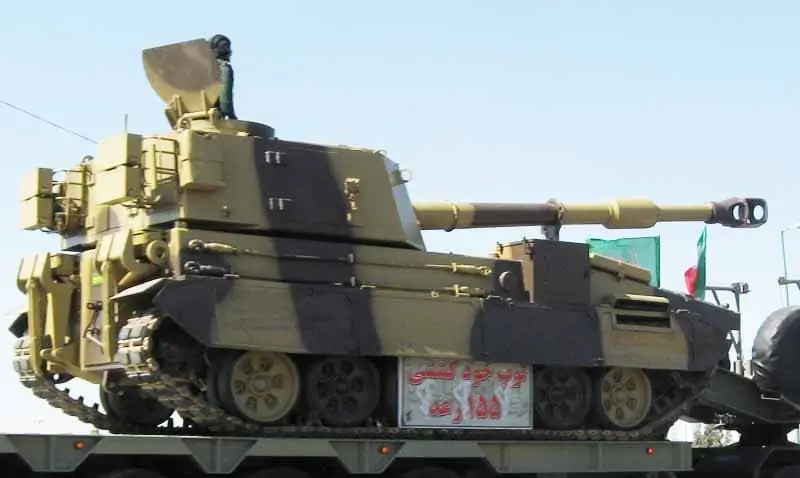
Raad-2
The larger Iranian system is Raad -2. It has a combat weight of 16 tons and a 155mm / 39 caliber barrel, it uses projectiles similar to the US-made M 185 used in the late production version of the M 109. The maximum flight range of a standard M 109 HE projectile is 18.1 km. An increase in the range is possible due to the modernization of the projectile.
Japan has also developed its own self-propelled artillery systems for many years. The modernized old model Type 75 155mm - Type 99 has a longer flight range, thanks to the installation of a 155mm / 39 caliber barrel. Like many other Japanese weapons, the Type 75 was not offered for export.

Type 75 155mm
The South Korean company Samsung Techwin, under license from the current BAE Systems US Combat Systems, has assembled 1,040 pieces of M109A2 155mm self-propelled artillery systems, which are now operated by South Korea. However, since that time, the South Korean armed forces have been replenished with a 155 mm / 52 caliber K9 system manufactured by Samsung Techwin, which has been in operation for 10 years and is the next modification of the M109A2.
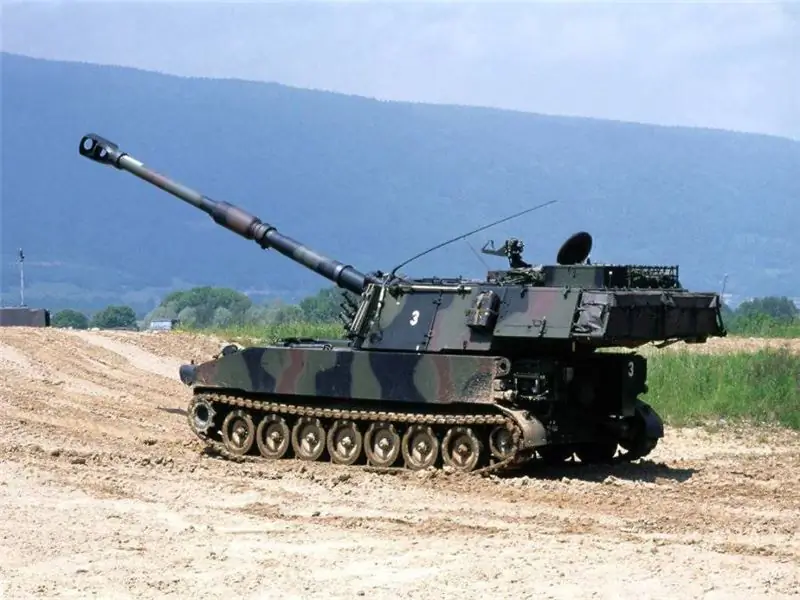
M109A2 155mm
The K 9 has a combat weight of 46.3 tons and has a standard range of the 155-mm M107HE projectile of 18 km, which can be increased to 40 km using the HE BB projectile.
In support of the K9, the K10 vehicle was developed to supply additional ammunition; it is currently in production and is being commissioned.
The K9 is also produced in Turkey using equipment from the Turkish Ground Forces Command. More than 250 units were produced under the local name Firtina.
In exchange for the self-propelled artillery systems currently in operation, Poland chose the 155 mm / 52 Krab caliber system for itself. It is produced locally, is a tracked system, equipped with a version of the AS 90 turret with a 155mm 52 caliber barrel manufactured by BAE Systems Global Combat Systems. The first order was made for 8 systems, which will be assigned to 2 batteries, 4 systems each. This order must be completed by 2011.
The Russian army still uses a large number of older self-propelled artillery systems, including the 203mm 2S7, 152mm 2S5, 152mm 2S3 and 122mm 2S1. It is planned that these systems will be in operation for several more years.
The newest Russian self-propelled system - the 152-millimeter 2S19 MSTA-S - was put into service in 1989, but since then it has been constantly modernized, especially in the field of fire control systems.
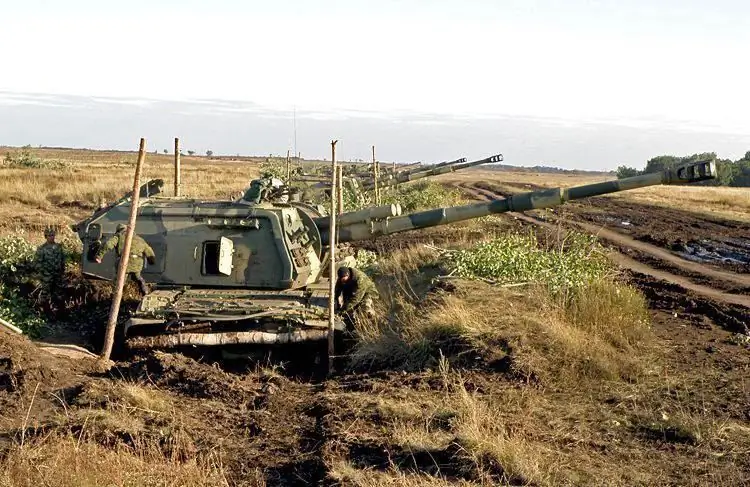
2S19 MSTA-S
The 155 mm / 52 gauge system 2S9M1 was offered as a sample for export, but no sales have been made so far.
Several years ago, Russia completed a prototype of the unique 152-mm twin self-propelled artillery system Koalitsiya-SV, but it remained at the testing stage.
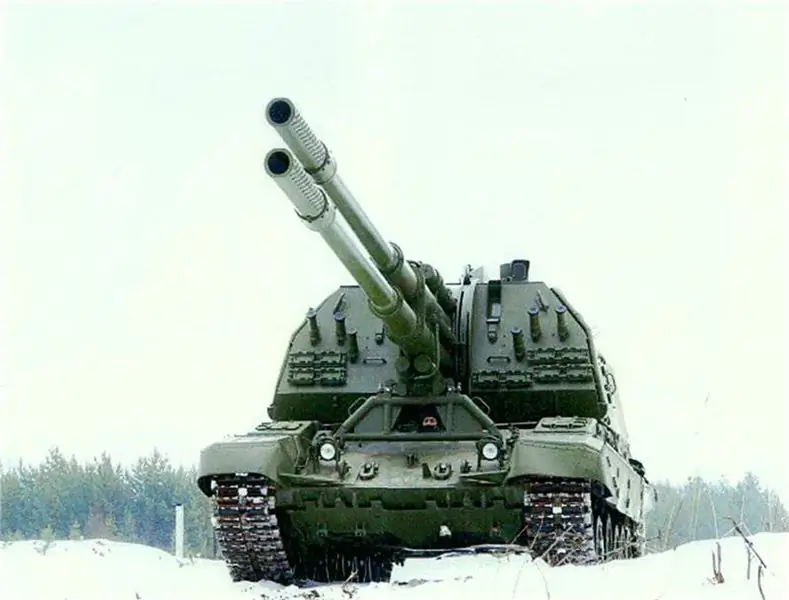
Coalition-SV
In Singapore, following the development and launch of a number of 155mm towed systems - including the FH-88 (39 gauge), FH-2000 (52 gauge) and the later Pegasus light towed howitzer (39 gauge) equipped with an additional power supply unit (APU) - Singapore Technologies Kenetics (STK) has taken up a new self-propelled artillery system. It's called Primus and it goes without saying that all 54 systems produced were shipped to the Singapore Armed Forces (SAF).
Primus is a tracked system, fires 155 mm / 39 caliber rounds, is equipped with a semi-automatic loading system, the projectile with a fuse is loaded automatically, and the powder charge is manually loaded. Ammunition consists of 26 155-mm rounds and the corresponding powder charges (charge modules).
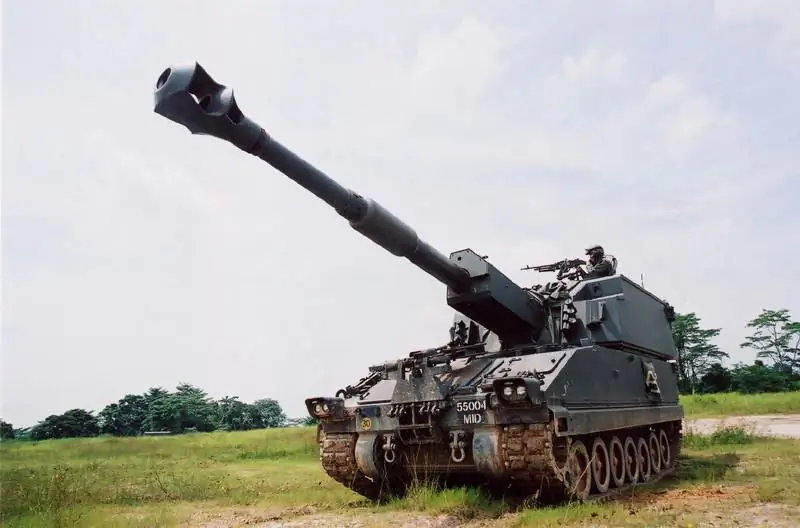
Primus 155mm
The Spanish army, meanwhile, operates a fleet of 155-mm self-propelled systems M109A5E, and their local manufacturer, GDSBS, is currently modernizing this system, one of the aspects of which is the installation of a digital navigation, aiming and guidance system (DINAPS).
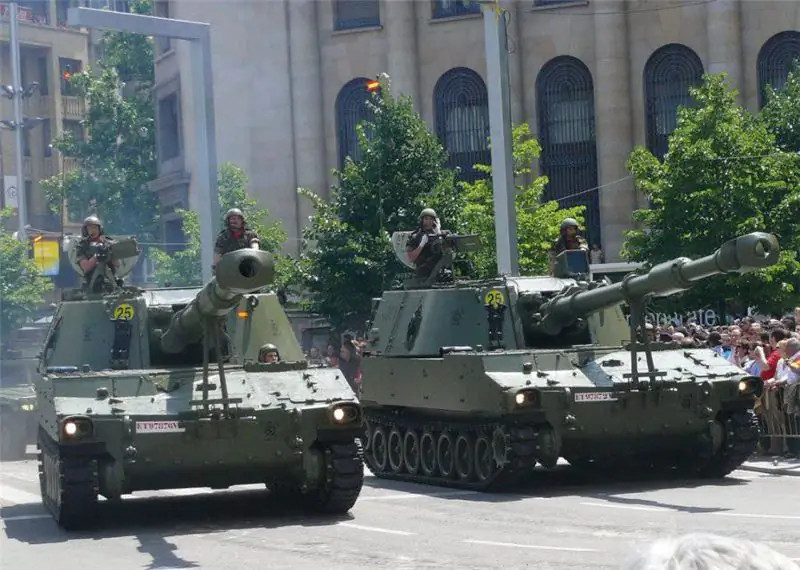
M109A5E
DINAPS is a modular system that combines a hybrid navigation system (inertial and GPS), a radar muzzle velocity sensor, navigation and ballistic software that allows you to connect to the command and control system of the Spanish army.
The navigation unit determines the angles of horizontal and vertical guidance of the barrel, makes automatic adjustments to the data of the projectile, charge and meteorological conditions, while the automatic guidance system (AGLS) is used in combination with DINAPS to aim the weapon at the target.
In Switzerland, RUAG Land Systems upgraded 348 M109 self-propelled artillery systems, the improved model was named Panzerhaubitze 88/95 and is now presented on the export market.

Panzerhaubitze М109
The complete modernization involved the installation of a 155mm / 47 caliber artillery gun, which is accompanied by 40 155mm rounds with an appropriate number of charge modules. The maximum range of a standard projectile is 23 km. The system has a gun temperature sensor and a semi-automatic charger, which increases the rate of fire to 3 rounds in 15 seconds. Panzerhaubitze 88/95 is also equipped with a navigation and gun guidance system, which continuously provides the commander, gunner and driver with the necessary information displayed on the displays.
Other innovations include an upgraded electrical system, a remote cannon release system and a fire detection and extinguishing system.
Switzerland also supplied additional M109A3 systems to Chile (24) and the United Arab Emirates, but these were not upgraded prior to delivery.
The Royal Artillery of the British Army currently uses only the 155 mm / 39 caliber self-propelled system AS90 manufactured by the current company BAE Systems Global Combat Systems. These systems, a total of 179 pieces, were supplied by what was then called Vickers Shipbuilding and Engineering Ltd (VSEL). It was planned to upgrade the systems by installing an extended range artillery gun (52 caliber) and a modular charge system (MCS), but the program was suspended.
The AS90 is currently undergoing upgrades in a number of key areas under the Capability Expansion Program (CEP) to extend its useful life, but BAE Systems Global Combat Systems no longer offers the system to the market.
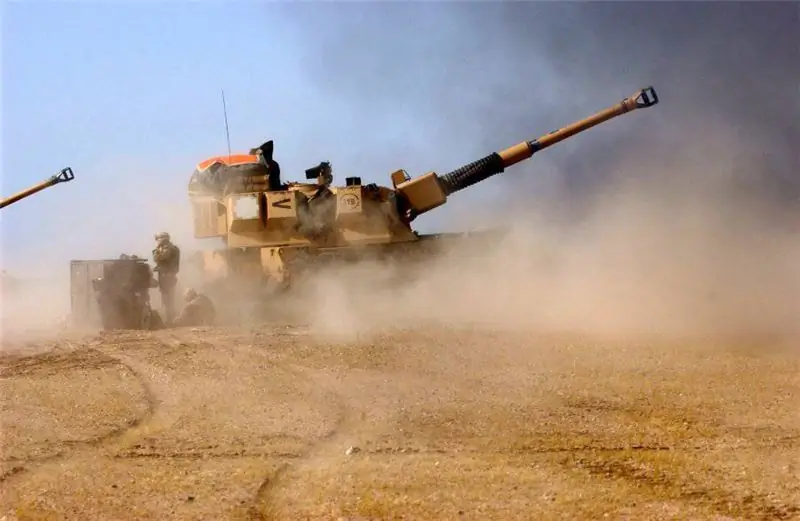
AS90
In the USA, due to the expiration of the service life of the 203mm M110 and the 175mm M 107, the 155mm M109 is the only self-propelled system in service.
The newest version - the M109 A6 Paladin - is equipped with a 155 mm / 39 caliber artillery gun, a new turret and an upgraded chassis.
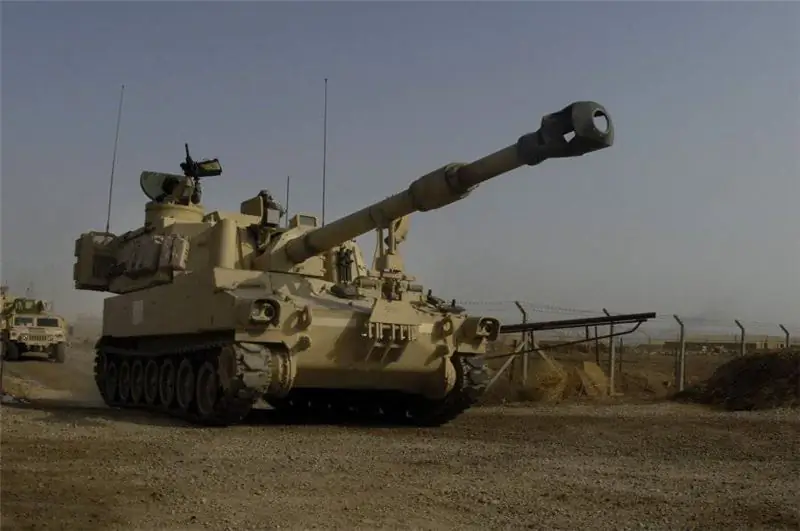
M109 A6 Paladin
The US Army received a delivery of 975 M109 A6 Paladin Self-Propelled Systems from BAE Systems US Combat Systems, plus an equal number of M 992 A2 Ammunition Transport Assistants (FAASV).
The US Army hopes to upgrade most of its M109A6 Paladin fleet to the M109A6 Paladin Integrated Management (PIM) standard. The first model of this system was released at the end of 2007.
The M 109 A 6 Paladin PIM has an upgraded M 109 A 6 Paladin turret mounted on a new chassis, which is also used for the Bradley assault vehicles used by the US Army.
At the same time, the development of a new 155-mm self-propelled system was started following a reduction in the program of the promising 155-mm Crusader self-propelled system. 155mm / 38 caliber NLOS-C (Non-Line-of-Sight Cannon) produced by the current BAE Systems US Combat Systems was part of the Advanced Combat Systems (FCS) program of the US Army, and the first NLOS-C P 1, one of the first five prototypes produced, was released in 2008.
The NLOS-C P1 crew consists of two people, the system is equipped with a 155mm / 38 caliber artillery gun with an automatic shell loading system, which first loads the projectile and then MCS.

NLOS-С P1
Earlier this year, the US Department of Defense announced the closure of that part of the Advanced Combat Systems program, which is associated with controlled equipment, including NLOS-C, and at the moment all work is frozen. The US Army is now studying its future needs for self-propelled artillery.
BAE Systems Global Combat Systems continues to supply the 155mm / 52 gauge International Howitzer and may also upgrade additional US Army M 109s for export.
Wheel systems
In recent years, there has been a clear trend towards the creation and implementation of self-propelled wheeled artillery systems.
Compared to their tracked counterparts, self-propelled wheeled systems offer a number of significant operational advantages. These include great strategic mobility, as they move quickly over long distances without the aid of heavy equipment transporters (HET). It was also stated that they have lower operating costs, they are more accessible to manage and maintain.
China has developed a number of self-propelled wheeled artillery systems, and NORINCO is putting on the market at least 2 of them - SH 1 and SH 2 - for potential overseas customers.
The most powerful system is SH 1 (6 x 6), which has an all-terrain chassis, a protected cockpit and a 155mm / 52 caliber artillery gun mounted in the stern. The vehicle is operated by a team of 6 people, has a combat weight of 22 tons and a maximum speed of 90 km / h.
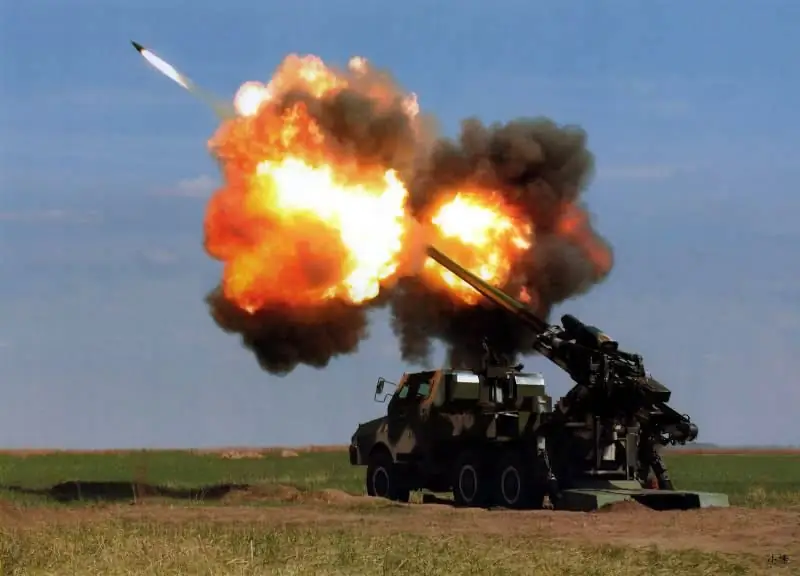
SH 1 (6 x 6)
It has a computerized fire control system, ammunition load of 20 155-mm rounds and corresponding charge modules with a maximum projectile flight range of 53 km when firing HE E RFB BB RA manufactured by NORINCO.
Less powerful NORINCO products include the SH 2 system, based on a new 6x6 all-terrain chassis with front and rear wheel steering. The 122mm cannon, developed from the NORINCO in-house towed D -30 cannon, is mounted on a platform in the center of the chassis.
The maximum range of the SH 2 projectile, when firing HE BB RA, is 24 km. The combat set consists of 24 projectiles with charge modules. Like the larger SH 1, the SH 2 has an integrated computerized fire control system.
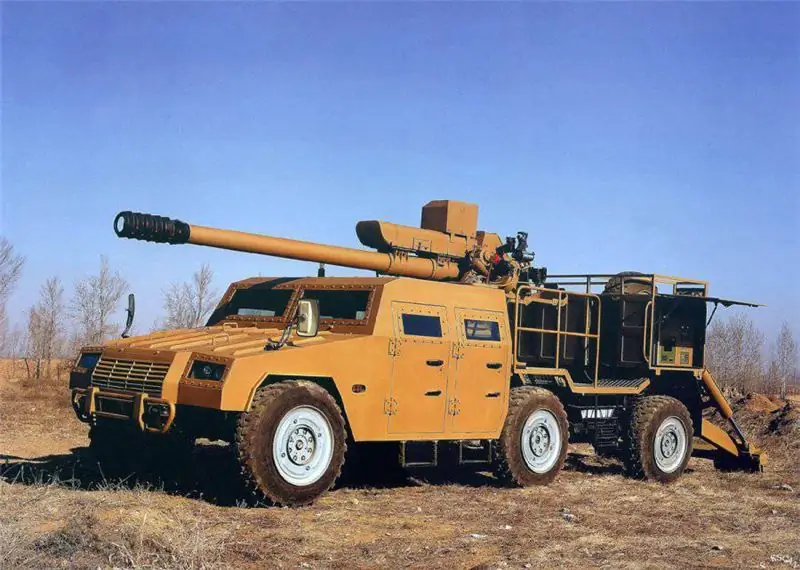
SH 2
NORINCO began production of a new version of the SH 2 - SH 5 - in which the 122mm D-30 gun was replaced with a 105mm / 37 caliber gun. This system is operated by a team of 4 people and has a maximum projectile range of 18 km when firing HE BB shells.
China has developed a number of other wheeled self-propelled artillery systems, including one based on the chassis of an 8x8 armored personnel carrier, which in the future may well be used in PLA military operations.
In France, Nexter Systems privately developed the CAESAR 155mm / 52 caliber self-propelled artillery system, the first test model of which was presented in 1994.

CAESAR
This was followed by a pre-production model, which the French Army modernized before placing an order for 5 systems for testing at the end of 2000. They were delivered in 2002/2003, four of them were given to artillery units, and the fifth was left for combat training, in reserve.
The French army decided to upgrade part of the GCT (AUF1) 155-mm tracked systems to the AUF2 configuration level, including the installation of 155mm / 52 gun calibers.
As a result, it was decided to remove the existing 155-mm AUF1 guns, and in 2004 the French army signed a contract with Nexter Systems for the supply of 72 CAESAR systems. The first copies were provided in July 2008, and by mid-2009 there were 35.
CAESAR of the French Army is based on a 6x6 Sherpa truck chassis manufactured by Renault Trucks Defense with a fully protected cab.
The 155mm / 52 caliber gun is installed in the rear of the machine, equipped with a large opener that lowers before opening fire to provide a stable platform.
The system has a computerized fire control system to ensure the execution of automatic operations, the ammunition load has 18 rounds and the corresponding number of charge modules. The maximum range of the HE BB projectile is 42 km.
To date, 2 foreign buyers have placed orders for the CAESAR system. The Royal Thai Army ordered 6 systems (they have already been delivered at the moment) and an unnamed export buyer - it was determined that this is the Saudi Arabian National Guard (SANG) - made an order for 100 units. The latter are based on Mercedes-Benz 6x6 truck chassis.
The Israeli company Soltam Systems has extensive experience in the design, development and production of various towed artillery systems and tracked self-propelled systems.
It has now entered the wheeled market with the ATMOS 2000 (Autonomous Truck Mounted Howitzer System), which is currently being marketed with a 155mm barrel with 39, 45 and 52 caliber barrels, fire control options vary based on customer preference.
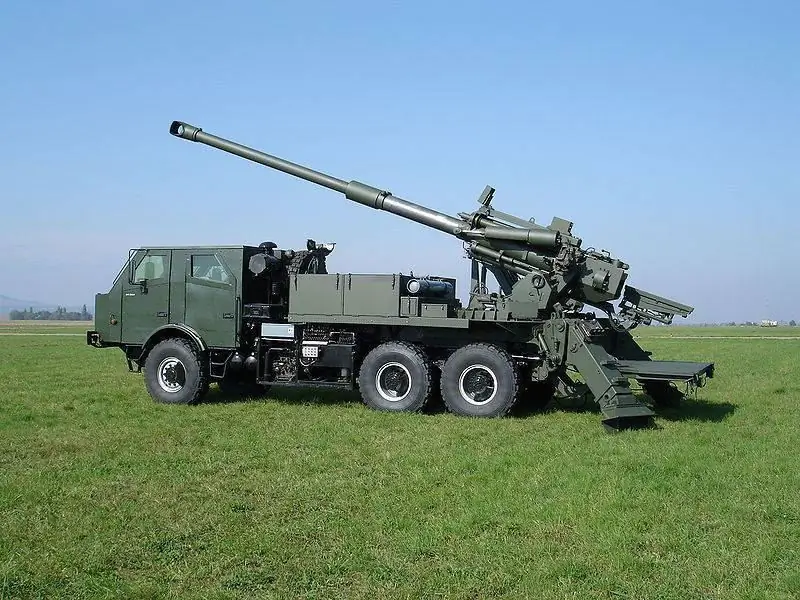
ATMOS 2000 (Autonomous Truck Mounted Howitzer System)
The system has been evaluated by the Israel Defense Forces (IDF) and is planned to be introduced to the IDF fleet in support of the upgraded 155mm Doher M109 systems.
ATMOS can be installed on any chassis, the control cabin is in the front of the system, the implement is installed in the rear. The maximum range of the projectile depends on the projectile / charge combination, averaging 41 km.
The first export buyer of the system was Uganda, which took delivery of the first shipment of 3 units. To meet Romania's needs, the company has developed a 155mm / 52 gauge ATROM in conjunction with the Romanian company Aerostar. It is based on a domestically developed 6x6 ROMAN cargo chassis and an ATMOS 155mm / 52 caliber gun mounted at the rear of the system.
The Russian 122mm D-30 towed gun is the most commonly used in the world. To increase its mobility, Soltam Systems has developed a self-propelled version of the D-30 called the Semser.
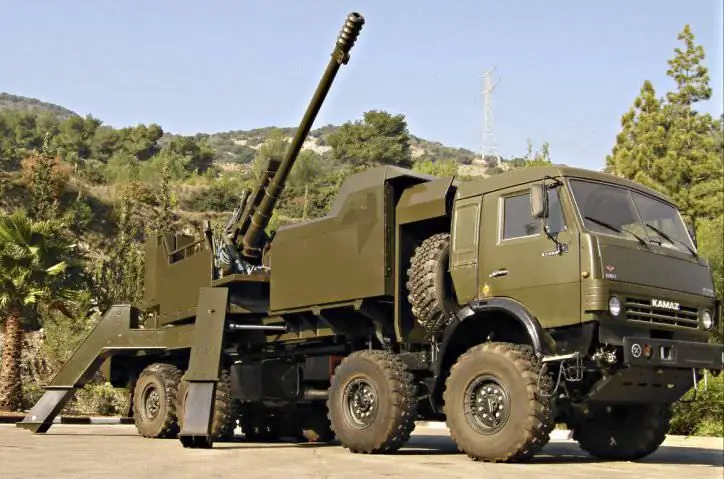
Semser D-30
Kazakhstan became the first buyer of Semser. The system is adapted to the rear of the KamAZ 8x8 all-terrain chassis.
The former Yugoslavia has significant experience in the design and manufacture of towed artillery systems, as well as in the modernization of old systems.
Serbia has continued this tradition and is currently producing a 155 mm / 52 gauge self-propelled system NORA B-52, which is based on the KamAZ 63510 8x8 truck chassis.
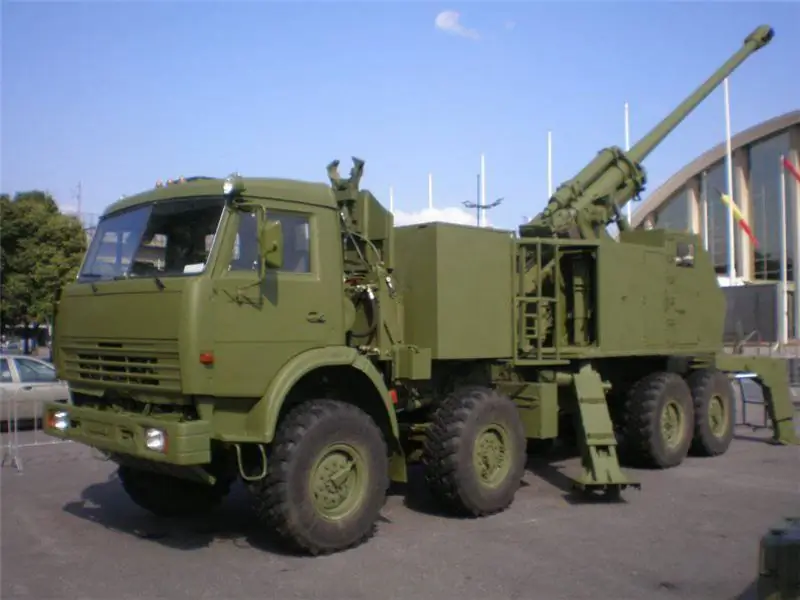
NORA B-52
155mm / 52 caliber gun mounted on a turntable in the rear of the chassis; while driving, the barrel is fixed in front of the system, and during fire, the gun shoots from the rear. The ammunition load consists of 36 rounds and the corresponding number of charge modules, the maximum range of the ER FB BB projectile is currently 44 km.
As in many systems of this type of recent production, it is possible to install various fire control systems, including the latest version with automatic guidance, a command and control system and an additional power supply.
In the 70s of the 20th century, Czechoslovakia developed the Dana 152mm self-propelled artillery system, which was based on the Tatra 8x8 armored truck chassis. About 750 units were produced for the domestic and foreign markets, many of which are currently in operation.
Further development of the Slovak self-propelled guns ended with the production of 155mm / 45 Zuzana calibers, modernized in many aspects. The system is based on the Tatra 815 series all-terrain chassis, has a protected crew cab at the front of the system, a fully enclosed turret in the middle and a protected engine compartment at the rear.
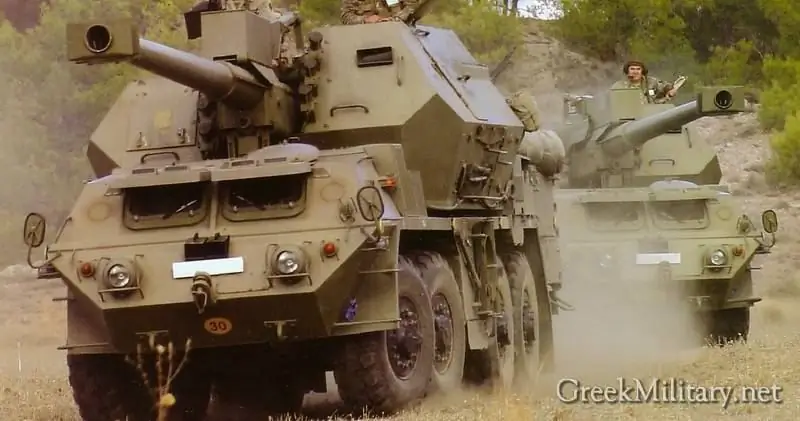
Zuzana
In addition to being exploited by the Slovak Army, Zuzana was also sold to Cyprus and later to Georgia.
For testing purposes, the turret was placed on the T-72 M1 tank chassis and as a result of further development, the Zuzana 2 155mm / 52 caliber system was obtained, which is based on the new Tatra chassis and is still at the prototype testing stage.
In order to meet the demands of the South African army, a 155mm / 45 caliber 6x6 self-propelled howitzer-gun G6 was developed, using the same gun as the towed G5.
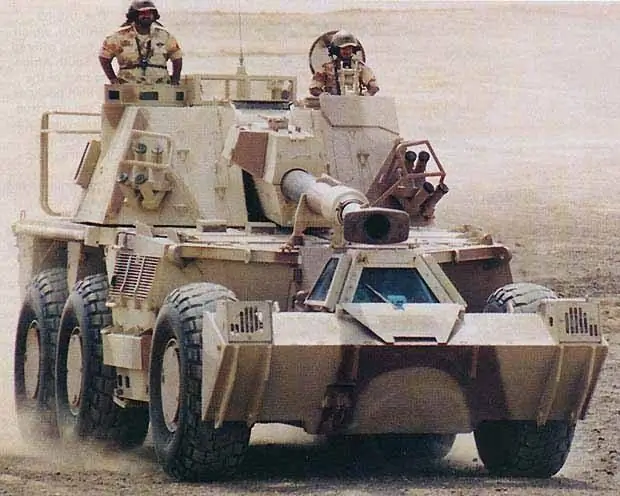
self-propelled howitzer-gun G6
South Africa received 43 units, with 24 units exported to Oman and 78 to the United Arab Emirates.
The G6 has a combat weight of 47 tons, is usually operated by a team of 6 people, and has a range of 700 km. The ammunition load is 45 155-mm rounds and charges developed by Rheinmetall Denel Munitions.
The maximum flight range of the 155-millimeter HE BB charge is 39.3 km, but this distance can be increased to 50 km by using a high-explosive fragmentation projectile with an increased range of fire (VLAP), already produced for export.
The result of further developments by Denel Land Systems was the 155mm / 52 caliber self-propelled artillery system G6-52, which is based on an upgraded chassis, has a new turret system with an integrated automatic loading system for 155mm projectiles. This contributes to a high rate of fire of up to 8 rounds per minute. The turret has 40 155-mm rounds of ammunition, and an additional 8 155-mm rounds are located in the chassis.
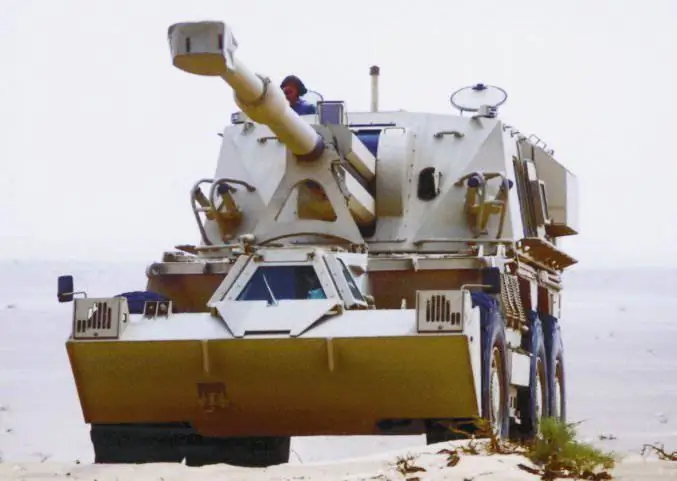
self-propelled artillery system G6-52
This system is based on the latest G6 chassis, it has also been successfully tested on the T-72 MBT chassis (for India), and in this form the system is called T6. The development of this system has not yet been completed.
Denel Land Systems is also developing the T5 Condor 155mm self-propelled artillery system for export. The first instance was installed on a Tatra truck chassis with a carrying capacity that provides towing of 155mm / 52 calibers of the G5-2000 artillery system. An automatic implement control system is built into the system as standard. The complex can also be installed on another chassis.
Denel Land Systems is developing a new version of the 105mm LEO (Light Experimental Armament) towed system, which will feature its installation on a truck. Together with General Dynamics Land Systems, it developed a test self-propelled version of the system, with a turret mounted on an 8x8 chassis of a light armored combat vehicle (LAV).
At the same time, BAE Systems Global Combat Systems is currently completing work on the 6x6_ FH-77 BW L52 Archer self-propelled system. An order is expected for 48 units of this model, 24 of which will be shipped to Norway and another 24 to Sweden.
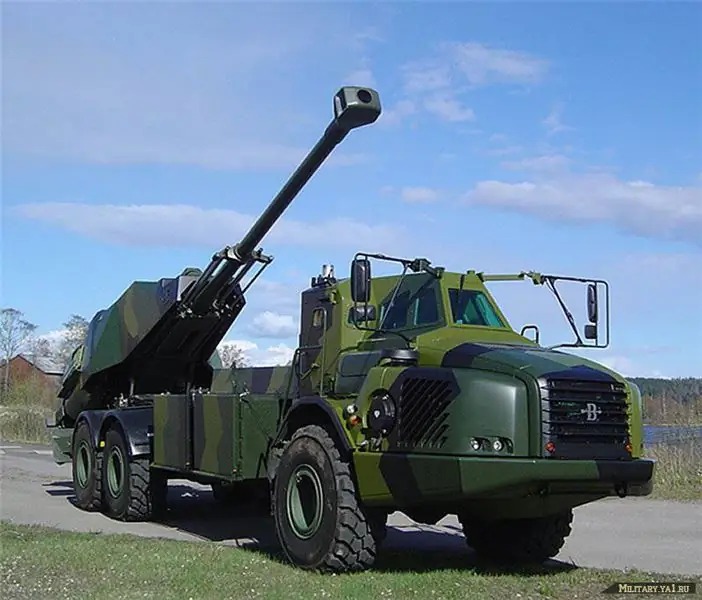
FH-77 BW L52 Archer
The Archer is based on Volvo's 6x6 all-terrain chassis, has a fully protected cab in the front of the system and a 155mm / 52 caliber gun in the rear. The weapon is controlled, guided and launched by the command located in the cockpit.
The ammunition load is 34 rounds and the corresponding number of charges, the average flight range is 40 km for a standard projectile, and 60 km for an extended-range projectile.
In addition to using conventional projectiles, the system can use more advanced technologies such as BONUS top-attack projectiles and Excalibur precision-guided projectiles.
Development of projectiles
In recent years, numerous developments have been carried out in the field of ammunition, especially artillery shells and charge modules.
The traditional types of ammunition: high-explosive, smoke and light were supplemented with extended-range projectiles with a gas generator or a rocket booster, or projectiles that combine these characteristics.
To repel a massive armed attack, 155-mm (and other caliber) container shells were developed and put into operation, stuffed with a large number of smaller shells equipped with HEAT-type HEAT anti-tank warheads.
Some shells had a self-destruct mechanism, others did not, as a result of which large areas were bombarded with unexploded shells that impeded the advance of friendly troops.
As a result of the convention on cluster munitions, a ban was introduced on the use of cluster munitions as well as missiles with this kind of subcharge, but a number of countries still produce and use such munitions.
To suppress high-value targets such as tanks and artillery systems, an improved 155mm overhead projectile has been developed and put into production. These include BONUS shells from Nexter Munitions / BAE Systems Global Combat Systems (used by France and Sweden) and German SMArt shells used by Australia, Germany, Greece, Switzerland and the United Kingdom.
The US Army introduced the Copperhead Guided Artillery Projectile (CLGP) many years ago, and although they are nearly expired, they are still on the registry today.
The Russian Instrument Design Bureau (KBP) has developed a series of laser-guided artillery shells, including the 152mm Krasnopol (now also has a 155mm version). These shells were sold to France and India, where they were later used in the 155-mm Bofors FH-77B systems during the hostilities with Pakistan. At the moment, NORINCO supplies the market with 155-millimeter shells similar to the Russian Krasnopol in characteristics.
Russia has also developed a 120mm version of laser-guided artillery shells - Gran (the entire system is called KM-8) for use in 120mm mortar systems, and Kitolov - a 122mm version for towed and self-propelled systems.
Canada and the United States have successfully deployed early versions of Raytheon's 155mm precision-guided missiles (PGM) Excalibur in Afghanistan. In the future, mass production of such missiles is planned. Every effort is being made to reduce their cost and make them widely used.
ATK also took part in the competition, providing the US Army with artillery shells equipped with a precision targeting system with remote detonation functions (PGK), they replaced the existing artillery fuses.
During tests, the system showed a total probable deviation of 50 m with a range of 155-mm M589A1 projectile at 20.5 km.
The introduction of PGK will contribute to a significant reduction in the required number of projectiles to neutralize the target, which, as a result, will entail an overall reduction in ammunition costs.
Conventional tank-type projectiles are currently being actively replaced by modular MCS or uni-MCS, where 5 modules are used in the 155mm / 39 caliber system and six in the 155mm / 52 caliber system.
They are easier to operate and are also suitable for any self-propelled system with an automatic loading system.
Many countries pay special attention to the development of ISTAR, which helps to facilitate target detection by artillery units. Such developments include unmanned aerial vehicles (UAVs), various types of radars and other military sensors, such as laser rangefinders / pointers, and day / thermal imaging devices that can detect and detect targets at long distances.
Forward-looking requirements
Due to recent advances in ammunition and charge modules, towed and self-propelled systems will continue to play a major role in hostilities, but other systems are likely to be introduced in addition to them.
For example, the US Army's FCS (Advanced Combat Systems) program has developed a closed-position rocket launcher (NLOS - LS), consisting of a launch canister unit (CLU) containing 15 vertically mounted precision-guided missile (PAM) or cruise missiles. (LAM). At the moment, development is underway on the LAM, in order to increase its flight range to 70 km. Despite the order to stop the entire program, work on NLOS-LS for the US Army is still ongoing.
The United Kingdom is currently implementing the Team Complex Weapons program, in which the development of the Fire Shadow winged munition, the supplier of which is the MBDA company, is in the first place. They strive to provide the command of the ground forces with the ability to quickly capture and hit a target at large distances and with greater accuracy.
A large number of countries are now focusing on fire control and ammunition development, rather than the firing platform itself.
Traditionally, fire operations are carried out at the battalion, battery or troop level, but many of the recently deployed self-propelled artillery systems are equipped with an onboard computerized fire control system combined with a ground navigation system that would allow fire missions to be carried out autonomously.
This feature, combined with an automatic projectile loading system, allows a high rate of fire and MRSI firing missions to be achieved (simultaneous strike of multiple projectiles, “flurry of fire”).
These systems go into action much faster, carry out a firing mission and also quickly retire to avoid retaliatory artillery fire.






